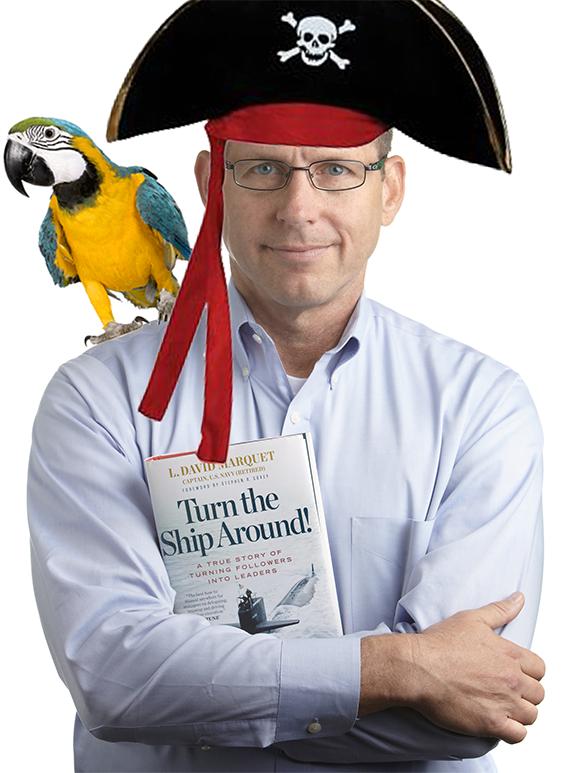Leadership is not for the Select Few at the Top

In his first book on intent-based leadership, Turn the Ship Around!: A True Story of Turning Followers into Leaders, David Marquet described his experiences as captain aboard the nuclear submarine USS Santa Fe. When he took command, the ship was, how shall we say… “underperforming.
However, after one year, Santa Fe was recognized as the most improved ship in the fleet, and In less than two years she shed her infamy as the worst boat in the navy and started winning awards as the best ship in her class.
Captain Marquet has released a workbook, The Turn The Ship Around! Workbook: Implement Intent-Based Leadership In Your Organization, to help others apply the framework he developed over those two years of experimentation to their own organizations – to build highly effective communities based on personal responsibility and trust
Imagine a workplace where everyone engages and contributes their full intellectual capacity, a place where people are happier and healthier because they have more control over their work — a place where everyone is a leader…. All of this is possible, but not with the current leadership paradigm.Our world’s bright future will be built by people who have discovered that leadership is the art of enabling. The steps getting there are evolutionary. The result will be revolutionary.
Sounds a lot like an agile transition to me….a journey filled with trust, ownership, and vision.
Creating an Environment Conducive to Change
In highly effective organizations, there are leaders at every level. To transition from the “Trainwreck Organization Chart” based on command and control, the existing “hierarchy” has to create the space that allows others to step up.
To start a transition to intent-based leadership, management at all levels needs to:
- Change their own thinking and create the possibility of new behavior by team members
- Change their own behavior and open up the opportunity for new thinking by team members
Existing leaders can start with some deep inquiry:
- Do you have to be the smartest person in your organization?
- To what degree does technical competence form the basis for leadership?
- Is that technical competence a personal competence or an organizational competence?
- How do you know what is going on “at the deck plate” in your organization?
The Power of Language
Leaders can start with a simple, but not easy, shift in their language patterns: resist the urge to provide solutions, and/or to give commands.
The concept is instead of giving answers to the ask “What should I do?” a leader responds with questions. And then leaves space for a response. (Don’t be like the Ben Stein character in Ferris Bueller’s Day Off)
Examples that Captain Marquet used to enable his team to step up were questions like:
- “What would you do if you were me?”
Another way he used was to help the asker to fast forward a bit:
- “Image it’s x days from now (end of the sprint)…what would you wish you had done today?”
One more method, if the issue was BIG and a bit overwhelming, was to ask about a piece of the decision:
- “How might you break that down into smaller problems?”
Parallels to Agile Coaching: In the coaching world, there are dozens of additional approaches to “just asking questions.” In all cases, the questions are open-ended, and do not provide the “solution” embedded within them. They all invite discovery, clarity and the opportunity for empowerment.
Letting Go of Ego: Expert leaders live in the realm of ego (e.g., “Others follow me because I am the authority”) and scarcity (e.g., “Few others can do what I can, so they need me”). Expert leaders see others, events, and circumstances as problems waiting to be solved.
Feedback Loops on Your Intent Based Leadership Experiments
How will people adapt to the changes? Well, it has been said, in various forms:
- [Rocket Science, Nuclear Physics, Software Development] is easy. People are hard
It will be pretty much impossible to know in prospect what the impact your intent based leadership experiments will have, but there are ways to know in retrospect. (Welcome to the complex domain!) One of the most powerful indicators -“instrumentations” – you can put into place will be to visualize the health and wellbeing of your team. See: Team Health and Wellbeing — A Leading Indicator of Just About Everything
There are scores of other metrics you can use, but please, please, I beg you, don’t choose velocity.
And when you observe things changing, reinforce and amplify the positives. Don’t recognize achievements so long after the event, that folks have forgotten what they did. Don’t wait for the monthly/quarterly team meeting. Use immediate recognition to reinforce the good stuff. Take 5 and show some appreciation.
And when things take a turn for the worse, it’s retrospective time. Change the experiment. Success often starts with failure.
Values and Principles Supporting Intent Based Leadership
Agile, as well as various frameworks, have their values and principles. Marquet’s Intent Based Leadership framework, (developed in 1999-2001; Agile Manifesto = 2001), has a great deal of overlap. A summary from Turn the Ship Around, with parallels to various agile-related values:
Initiative (Modern Agile: Make People Awesome; Agile: Projects around motivated people) Initiative means we take action without direction from above to improve our knowledge as submariners, prepare the command for its mission, and come up with solutions to problems. With each member of the command taking initiative, the leverage is immense. Initiative has been a hallmark of the American fighting man and a key reason for our success. Initiative places an obligation on the chain of command not to stifle initiative in subordinates.
Innovation (Modern Agile: Safety a Prerequisite) Innovation means looking at new ways of doing the same thing. It also means knowing which areas are “above the waterline” and appropriate to innovation, having the courage to change, and tolerating failures.
Intimate Technical Knowledge – Learning / Training / Competence (Modern Agile: learn rapidly; Agile: Technical excellence) Modern submarines are extremely complex. Intimate technical knowledge means that each of us is responsible for learning our area of responsibility. We make decisions based on technical reasons, not hope. We understand the details of our watch stations and the interrelationship of systems. We diligently study.
Competence means that people are technically able to make the decisions they make.
- Take deliberate action.
- We learn (everywhere, all the time).
- Don’t brief, certify.
- Continually and consistently repeat the message.
- Specify goals, not methods.
Courage (XP, Scrum) Courage means we choose to do the right thing, even if it may be uncomfortable. It means not just doing or saying what subordinates, peers, or superiors want to see or hear. It means admitting mistakes, even if ugly.
Commitment (Scrum) Commitment means we are present when we come to work. We give it our best. We choose to be here.
Continuous Improvement (Agile; Modern Agile)
- “Don’t be good – get better” – Agile Retrospectives and one of the 12 principles of the agile manifesto
- A little rudder far from the rocks to prevent a lot of rudder closer to the rocks.
- Even betters is “trim tab”
Continuous improvement is how we get better. We continually seek ways to learn from processes and improve them and ourselves. The chain of command has the obligation to develop and institute mechanisms (such as conducting debriefs) to achieve continuous improvement.
Integrity means we tell the truth to each other and to ourselves. It means we have a grounded base of reality and see things as they are, not as we want them to be. Integrity means we participate fully in debriefs, allowing improvements to be based on facts.
Empowerment (Emancipation) We encourage those below us to take action and support them if they make mistakes. We employ stewardship delegation, explaining what we want to be accomplished and allowing flexibility in how it is accomplished.
Teamwork (XP: Communication, Feedback, Respect; Scrum: Openness, Commitment Respect; Agile business people and developers) Submariners have traditionally worked as a team because a mistake by one person can mean disaster for all. We work as a team, not undercutting each other. The chain of command is obligated to implement mechanisms that encourage and reward teamwork. We back each other up in a positive way.
Openness (scrum, modern agile) We exercise participative openness: freedom to speak one’s mind. Additionally, we exercise reflective openness, which leads to looking inward. We challenge our own thinking. We avoid the trap of listening to refute.
Timeliness (Agile: early and continuous delivery, working software frequently) Timeliness means we do things on time: start work on time, qualify on time, are ready to start evolutions and drills on time, and get to rendezvous points on time. Timeliness also recognizes that accomplishing most things faster is better and that working to reduce inherent delays and time lags results in a more effective organization.
Getting “There” – Instituting the Leader-Leader Model
Marquet outlines a method for moving out of the archaic command and control paradigm to a modern model of leadership at every level.
Control
- Find the genetic code for control and rewrite it.
- Act your way to new thinking.
- Short, early conversations make efficient work.
- Use “I intend to . . .” to turn passive followers into active leaders.
- Resist the urge to provide solutions.
- Eliminate top-down monitoring systems.
- Think out loud (both superiors and subordinates).
- Embrace the inspectors.
Competence
- Take deliberate action.
- We learn (everywhere, all the time).
- Don’t brief, certify.
- Continually and consistently repeat the message.
- Specify goals, not methods.
Clarity
- Achieve excellence, don’t just avoid errors.
- Build trust and take care of your people.
- Rely on your legacy as inspiration.
- Put in place guiding principles for decision criteria.
- Use immediate recognition to reinforce desired behaviors.
- Begin with the end in mind. Encourage a questioning attitude over blind obedience.
Approaching Excellence…
- First, identify where excellence is created in our company.
- Then, figure out what decisions the people responsible for the interfaces need to make in order to achieve excellence.
- Finally, understand what it would take to get those employees to be able to make those decisions. This typically requires an intersection of the right technical knowledge, a thorough understanding of your organization’s goals, authority to make the decision, and responsibility for the consequences of the decisions made.
Grab the book for a deeper dive. (Sorry, I could not resist the pun.)
Don’t Empower, Emancipate!
I had the opportunity to speak with Captain Marquet. At the close of our conversation, we teased apart the difference between empowering and emancipating – a powerful distinction.
With emancipation, we are recognizing the inherent genius, energy, and creativity in all people, and allowing those talents to emerge.
We realize that we don’t have the power to give these talents to others, or “empower” them to use them, only the power to prevent them from coming out.
Emancipation results when teams have been given decision-making control and have the additional characteristics of competence and clarity.
You know you have an emancipated team when you no longer need to empower them. Indeed, you no longer have the ability to empower them because they are not relying on you as their source of power.
Ya think if intent based leadership worked in a billion dollar tube 400 meters under the sea, you might be able to get it to work in your organization?
Share the results of your experiments… I’d love to learn from them…
 Did this article help you out? Show your appreciation by buying me a virtual coffee. Help fuel more great content!
Did this article help you out? Show your appreciation by buying me a virtual coffee. Help fuel more great content! More on Intent-Based Leadership



